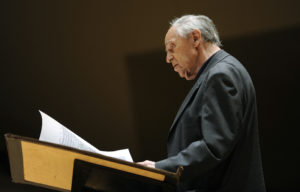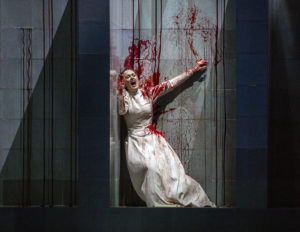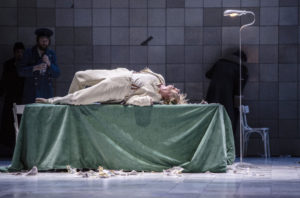I did not suppose that a short trip to Berlin before the season-opening production of The Queen of Spades in Oslo would come to occupy any longer-term place in my memory. I intended to see the Pierre-Boulez-Saal, opened a bit under 1.5 years ago at the new Barenboim-Said-Akademie, and assess its acoustics on the occasion of a concert by Ensemble intercontemporain as part of the Berlin Musikfest – at which Boulez’ legendary Le Marteau sans maître was preceded by Berg’s Four Pieces for Clarinet and Piano op. 5 and Grisey’s Vortex temporum. And after the charms of contact with the intimate, superbly-designed chamber music hall seating a bit under 700 – where every person in the auditorium follows the performers’ efforts from a distance not exceeding 14 meters – to experience the completely different atmosphere at Operahuset, which in 2008, after over 700 years, deprived the Gothic cathedral in Trondheim of its status as the largest public building in Norway. And there, in this Neo-Modernist wonder of steel, wood, white granite, Carrara marble and glass, growing out of the waters of a fjord like an iceberg – to see and hear Tchaikovsky’s blood-chilling opera in a production from Toulouse, freshened up after ten years and directed by Arnaud Bernard.
Meanwhile, the modest evening in Berlin provided me with material for lengthy reflections. For instance, on respect for the music of the Boulez-Saal’s patron and its accompanying contexts. Boulez took quite some time to familiarise himself with Berg’s œuvre; for this reason, it was a wonderful idea to include the latter’s miniatures for clarinet and piano on the program, in the superb interpretation of Martin Adámek and the ever-dependable Dimitri Vassilakis, who skillfully highlighted the dramaturgical potential contained in these pieces written in a still Webern-like spirit. In turn, Grisey – despite his respect for Boulez – criticised the premises of his compositional technique, opposing to it his own concept of spectral music. All the more, therefore, do I appreciate the decision to present Vortex temporum, a synthesis of the mature period of his œuvre, based on three forms of a sound spectrum and three levels of tempo, reflecting the different time of people and animals – a phenomenal work and outstanding performance under the baton of Matthias Pintscher, with the sensational Vassilakis at the retuned piano. Le Marteau sans maître, presented after the intermission, induced me in turn to reflect upon the art of adaptation. Boulez embodied the idea of total serialism, expanded to all parameters of the work; he deconstructed the solo vocal part, blurring the boundaries between voice and instrument; he broke with linearism of narrative. All of this in order to create an equivalent to the poetry of René Char – far from musical illustration of the text. It is a hammer not so much without a master, as taken over by another craftsman, namely Maître Boulez, as Salomé Haller – gifted with a distinctive though not too beautiful mezzo-soprano – highlighted perfectly, weaving the large intervallic leaps, glissandi and murmurandi in her part into the shimmering instrumental texture.
Pierre Boulez. Photo: Kai Bienert
It is in similar terms – as an adaptation – that we must treat Tchaikovsky’s The Queen of Spades. I previously wrote about the divergences between the libretto and the text of Pushkin’s novella on the occasion of the superb staging at Opera Holland Park in 2016. Out of professional obligation as a reviewer, I pointed out that in several episodes, director Rodula Gaitanou had too hastily set out on the path of Stanisławski and Meyerhold, who were the first to attempt to ‘reconcile’ the opera to its prototype. In order to convince oneself that that is not the way to go, it will suffice to have a look at the score, and then – for that extra bit of certainty – take a glance at the libretto too. The literary Countess is no demon: she ‘did not have a wicked soul; but she was capricious, as a woman spoiled by high society, stingy, and sunk in cold egoism, like all old people, whose time for love is in the past, and who are strangers to the present’ (tr. Richard Pevear). The opera’s Herman has little to do with the stingy, calculating, sometimes irrefutably ridiculous officer from Pushkin’s tale. He is a tragic figure with whom Tchaikovsky himself identified; furthermore, as Tchaikovsky’s correspondence shows, he all but boasted of this: Herman is a metaphor of the Russian intelligentsia member, a person with no prospects, aware that the spectre of extinction floats over the Empire. Tchaikovsky’s Herman falls into a gambling addiction because he is as poor as a church mouse – and he knows that only a win at the casino will open the door for him to marry his beloved Liza.
And indeed, he falls – and that, very gradually. The first symptoms of nervous breakdown appear in Herman only at the beginning of Act III. Meanwhile, in Oslo, the curtains parted on the sounds of the overture, revealing a regular madman shaken by convulsions, in a costume resembling a straitjacket. In the finale of Act I, Herman threatens Liza with a revolver – and that, a tiny one just right for a woman’s handbag; let us recall that according to the libretto, the scene finishes with a passionate embrace of the lovers. The tension does not grow, because there is nothing for it to grow out of – unless anyone was surprised by the episode with the Countess’ ghost appearing in the morgue, Liza’s death in the shower at the bathhouse with walls dripping with blood, or the sight of Herman dying from a suicidal shot in the crotch.
The Queen of Spades in Oslo. Svetlana Aksenova (Liza). Photo: Eric Berg
From the very beginning, I had the impression that I had seen it all somewhere before, and it had been equally nonsensical. Then I remembered: in the production of Lev Dodin, an otherwise superb theatrical stage director who has worked little in the opera, and only outside of Russia – not counting the staging of The Queen of Spades that premièred in 1998 in Amsterdam, made its way onto several other European stages, and then reopened a year ago in Moscow. Where it encountered withering criticism – for the aforementioned reasons. Dodin read Pushkin to the very end, recalled that Herman ‘sits in the Obukhov hospital, room 17, does not answer any questions, and mutters with extraordinary rapidity’ (tr. Richard Pevear), and decided to correct Tchaikovsky. In his version, the action plays out in the madhouse and in the protagonist’s sick imagination. Exactly as with Bernard, who juggles the narrative between the psychiatric hospital rooms and the interior of the decaying palace (admittedly, beautiful stage design by Alessandro Camera). So that it won’t be boring, he organises the pastorale from Act II at a Soviet commune set up ‘as an artist from the West imagines the daily life of a poor civil servant in the USSR’. The episode with Liza’s friends looks like it is taken straight from some Onegin production; and the finale at the casino, like a scene from the American film adaptation of Doctor Zhivago. To sum up, this entire conglomerate of hackneyed clichés, interpretative errors and overt plagiarism could only do harm to the musical plane of the show, especially in the ‘corrected’ version – that is, the perspective pushed to the limits of the absurd from Oslo.
A pity, because with such a cast, one can move mountains. Count Tomsky – the technically sensational Boris Statsenko, gifted with a sonorous and beautifully rounded baritone – emerged from the oppression reasonably unscathed. Yeletsky – in the person of the young and eminently promising Konstantin Shushakov – was characterized more as a pimp than a prince, and came off somewhat worse; even so, his ardent interpretation of the aria ‘Ya vas lyublyu’ from Act II was one of the brighter points of the production. Svetlana Aksenova – with a velvety yet movingly girlish, focused and intonationally very secure soprano at her disposal – would have been the Liza of my dreams, were it not for the increasing gulf between her part and what was happening onstage (and sometimes also in the orchestra pit, but more about that in a moment). The same applies to Herman (Peter Wedd), who has clearly toughened up in vocal terms since his London debut: he built the tension ideally in the arioso ‘Prosti, nebesnoye sozdanye’ and was enchanting with his fluent phrasing and deep lyricism in the excellent duet with Liza in Act III (bravos for both protagonists). His uncommon musicality and the beautiful, baritone-like tone of his voice make him eminently predisposed for this part – on the condition that he polishes his still artificial-sounding Russian and finds a director who will not encumber him with a multitude of acting tasks as awkward as they are unjustified. I was again disappointed by the Countess (Hege Høisæter) – yet another wonderful mezzo-soprano who realises this shocking part in a manner resembling the Witch from Humperdinck’s Hänsel und Gretel. However, I shall address many warm words to Tone Kummervold, who debuted in the role of Polina.
Peter Wedd (Herman). Photo: Eric Berg
It is a pity that the conductor as well – Lothar Koenigs, who is after all very experienced and highly rated by the critics – got in the way of these wonderful singers. He conducted The Queen of Spades like Götterdämmerung – with a heavy hand, without the characteristic Russian ‘sing-song’, not maintaining eye contact with the soloists, choosing bizarre tempi. The ghostly first scene of Act III slipped by, as it were, imperceptibly; the heartbreaking chorus in the finale – the composer’s intimate farewell to his beloved Herman, a superfluous man, the victim of a Mother Russia grown monstrous – ended as if cut off with a sharp knife. They covered Herman with plastic wrap for corpses, strapped him to the bed and rushed off into the wings. No one prayed for his tormented soul. No one prayed for Tchaikovsky.
Translated by: Karol Thornton-Remiszewski



